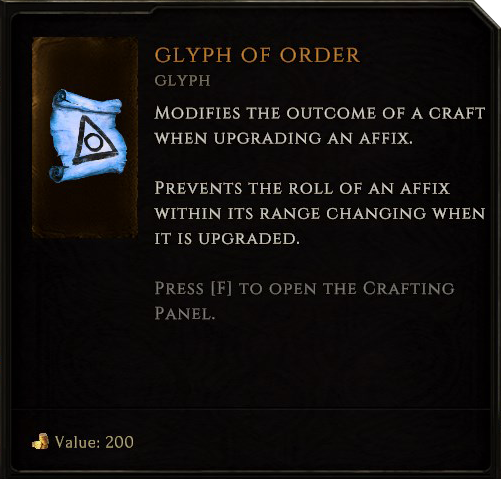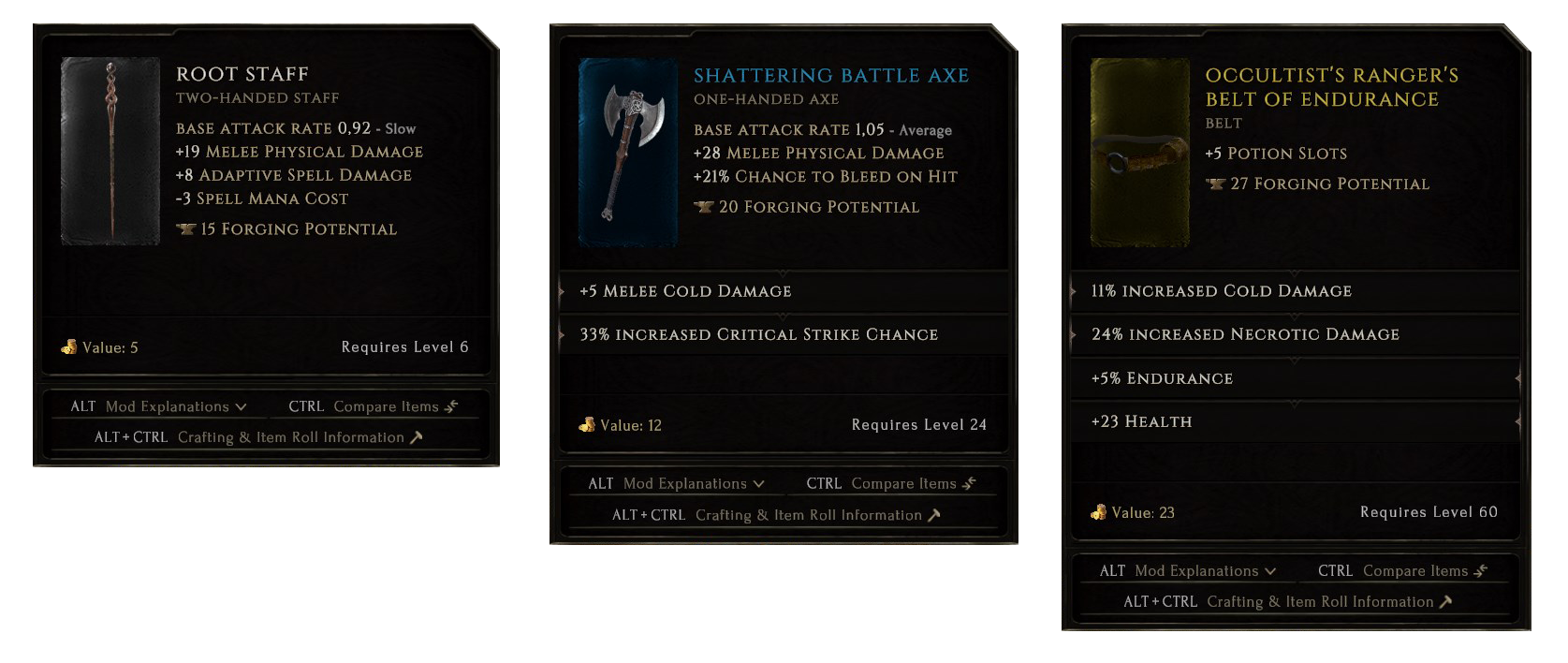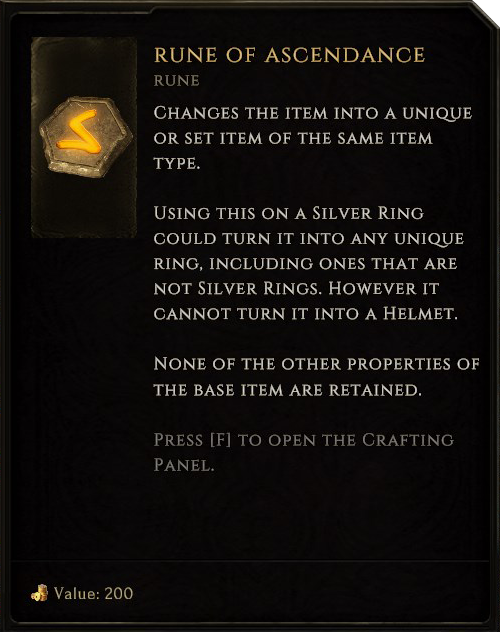Crafting Changes
The core of the crafting system has existed in a similar state in Last Epoch for the last four years. In that time we’ve had a lot of positive feedback, but a lot of people have also voiced their frustrations with it. In 0.8.4 we want to carry forward the positives, while reworking the core of this system to be less frustrating, and adding more variety to how you can craft in Last Epoch.
Positives to carry forward
- Directed Crafting: You can find shards on the ground for specific affixes and use them to add that affix to items or upgrade that affix on items that already have it. This is a very intuitive system that gives a great sense of control and progression to crafting, while providing plenty of crafting items to find and collect.
- An element of randomness: We want to keep a degree of randomness in crafting so that it can feel exciting and unpredictable. If you know exactly how an item is going to end up when you start crafting it, the whole experience can feel flat. We don’t think that the randomness of the current system works well, it can be very frustrating, but we still believe that keeping a significant level of unpredictability in the system is very important.
- Most of the existing runes: The Rune of Shattering is instrumental in allowing you to target farm specific Affix Shards, and the other Runes for the most part provide interesting ways to craft an item beyond just adding and upgrading affixes.
- The glyph system: While we’re not keeping either of the two existing Glyphs, the system by which you can support crafts with different items to modify the outcome has the opportunity to add a lot of depth. We’re hoping to capitalize on that more in 0.8.4, rather than making it mostly a maths based decision of which Glyph is most likely to result in more opportunities to craft the item further.
Negatives we want to avoid going forward
- Irrelevant Shards: Shards for affixes you didn’t want to use felt completely useless. At worst this could undermine the feeling of having frequent useful drops that you didn’t have to spend time evaluating, like you do with equipment.
- Magic vs. Rare Items: With the previous crafting system it often ended up being more optimal to start crafting from a magic item rather than a rare one for several reasons. A later part of this dev blog will go into more detail.
- Perception of Luck: The RNG of the system functioned in a way that resulted in players generally feeling unlucky when crafting. This came from two sources, an unintuitively high chance of failure, and a lack of opportunities to feel particularly lucky.
- This was mostly due to unintuitive failure chance over multiple crafts amounting from repeated attempts where failure chance is small, but not negligible. Human psychology doesn’t handle the perception of chance very well, overestimating the chance of success from a high percentage. This meant that items fractured more frequently than players expected, resulting in disappointment and frustration.
- Because success chance generally stayed high, the expectation with each individual craft was for it to succeed, and this meant that each success just felt expected or even owed rather than lucky. Whenever success chance dipped low enough that succeeding wasn’t the expectation and there might be an opportunity to feel lucky, there was a strong disincentive to just stop crafting, because of the risk of a damaging or destructive fracture. For some, this lack of lucky moments could also result in crafting feeling flat or dull outside of the occasional critical success or the disappointment of an unexpected fracture.
Forging Potential
In 0.8.4 we’re changing crafting to remove instability and fracture chance, and instead give all craftable items an amount of Forging Potential. Each craft uses a random amount of Forging Potential, normally around 1 to 15, and when an item runs out of Forging Potential it can no longer be crafted on, but until then all crafts will be successful.
Item_BaseExamples1095×537 391 KB
This has several immediate advantages:
- Clearer Expectations: There’s an expectation for how much you can craft on an item, and it’s clear how quickly it’s going down. The point at which you can no longer craft doesn’t come out of nowhere, but gets closer and closer as an item loses more forging potential. This is particularly important for new players who don’t always initially understand that crafting is limited in the old system.
- Softening the Blow: It doesn’t feel as bad when an item becomes ‘uncraftable’, because the last attempted craft always still succeeds, regardless of how much forging potential was left. There’s never a time where you attempt a craft and then the item just fractures instead and you don’t upgrade the affix you wanted to.
- Positive RNG: This system is much more conducive to creating moments where you feel lucky. Often an item is low on forging potential and it looks like you’re only going to get one more craft out of it. But through a mix of rolling low amounts of forging potential consumed, critical successes preventing forging potential consumption, and Glyphs of Hope - you can end up being able to craft far more times than you were expecting.

Crafting Bases: Magic vs Rare Items
As mentioned above, with the previous crafting system it was often more optimal to start crafting from a magic item. There were several causes of this that we’re planning to address with the 0.8.4 crafting changes.
- There was no good, or easy, way to get rid of mods you didn’t like. There was the Rune of Removal, but that had a high risk of removing affixes that you did want and that made the item worth crafting on in the first place. This meant that bad mods were significantly worse than empty mod slots.
- One of the ways we are planning to solve this is the Glyph of Chaos which can be used to reroll affixes when they’re upgraded, giving you several shots of changing an affix to one you want.

- There were only two Glyphs and they both extended the average number of times you could craft the item. Either by reducing stability added or by reducing fracture chance. There was no opportunity cost to using one of these so there wasn’t as much of an advantage to starting from an item that required particularly few crafts to complete.
- We are aiming to solve this by introducing new Glyphs that allow you to push an item further or refine it at the opportunity cost of not using a Glyph that could preserve Forging Potential. For example you can use the Glyph of Order to preserve a good roll you get on a lower tier and carry that forward to higher tiers.

- Rare items started with more instability than magic items, so the gap between their mod count and total tiers could be closed more easily.
- We’re flipping that around with the new crafting system so that rare items start with more forging potential than magic items, and rare items at high levels drop with even more. This means that not only will that gap be harder to close for magic items, but when crafting on rare items you’ll have more freedom to use items like the Glyph of Order without worrying as much about running out of forging potential.

On a related note, we also want to shield players from bad RNG when crafting on exalted items, as that process is inherently more risky due to exalted items being much less easily replaceable. Because of this exalted items drop with particularly high forging potential.
Item_ExaltedExamples1150×771 582 KB
Runes and Glyphs
This patch we’re swapping the old two Glyphs for four new ones, replacing one Rune, and adding two new Runes. Three of these new crafting items will be chase items with more exciting and powerful potential outcomes than the existing Runes and Glyphs.
One of our goals with overhauling Glyphs was to make the decision around choosing the one you wanted to be based more on strategy and what sort of outcome you wanted, rather than the math of which was more likely to result in you being able to craft the item further. On account of that, the roles of the Glyph of the Guardian and the the Glyph of Stability have been rolled into the new Glyph of Hope, which gives a chance that a craft will consume no forging potential.
Glyph of Chaos
- As mentioned above this glyph rerolls an affix when you upgrade it. This means that rare items with one or two affixes you don’t want become much more viable bases for crafting. This also adds a degree of RNG that isn’t just about success, failure, or using up a resource.
- The Glyph of Chaos also solves another problem with the old crafting system, which was that shards of affixes you didn’t want could feel completely useless. You’ll now want to have at least a few of every shard on hand so that you can reroll their respective affixes.
Changes to Existing Runes
-
The Rune of Shattering and Rune of Refinement are not changing. We like the role they played in the old crafting system and think they’ll continue to work just as well in this new one.
-
As discussed above the Rune of Removal could lead to moments of frustration when it removed the one affix that made the item exciting for you in the first place. Of course the Glyph of Chaos provides an alternative now, but if you do want to use the Rune of Removal, the edge will be taken off the disappointment, because it’ll return a number of shards of the removed affix equal to its tier. This will allow you to more easily craft that affix onto a different item instead. This also opens up the strategy of using multiple Runes of Removal instead of a Rune of Shattering if you want to maximize the number of Shards you get from an item.

-
The Rune of Shaping will no longer favour moderate rolls, making it more exciting to use and giving it more of a potential to create really powerful items. We felt comfortable doing this because with the new system we can simply balance it by giving it a higher maximum forging potential cost.
-
The Rune of Cleansing is being removed. In 0.8.4 rare and exalted items drop with high Forging Potential to encourage crafting on those rather than creating the exact items you want from scratch, being able to use a Rune of Cleansing to turn those into high forging potential white items would bypass that, so the rune is being removed.
Rune of Discovery
- This is a new rune being added in 0.8.4. It costs no forging potential and adds random T1 affixes to all the empty affix slots on an item.
- This is mostly intended to provide another option for crafting in early game, where you’re not looking for a perfect item, but a grab bag of random affixes could be a potential upgrade, or you might want to round out the affixes of an item with low forging potential.
- All your old runes of cleansing will be turned into Runes of Discovery.

Rune of Ascendance
- The first of the three chase crafting items. This transforms an item into a random unique or set of the same type.
- The subtype does not matter, just the item type. For example using a Rune of Ascendance on a silver ring can result in any unique or set ring that could randomly drop, but cannot result in a unique helmet.

Rune of Creation
- Another chase crafting item, this removes all the item’s remaining forging potential, and then duplicates it.
- Beyond being able to equip both copies in the case of things like rings and one handed swords, this will have another use that will become clear in the run up to 0.8.4.

Glyph of Despair
- This is the only chase Glyph, and it has a particularly exciting effect. Whenever you use a shard to attempt to upgrade an affix while using a Glyph of Despair there is a chance that the affix will be sealed instead of upgraded.
- A sealed affix moves to its own slot and cannot be modified further. However this means that the prefix or suffix slot it previously occupied is now open to allow for another affix to be added, allowing you to craft 5 affix items.


Crafting Outcome UI
Another change to the crafting system in 0.8.4 is that you can now see the outcome of your crafts. This display is positioned at the bottom of the crafting panel where the various fracture chances used to be displayed. It tells you what stats you gained from a craft and how much Forging Potential was lost, if any.
Crafting_UI818×1214 83.4 KBCommunity feedback is always valued and has been instrumental in providing direction for the crafting changes we’re making this patch. We hope that you enjoy the changes and that you’ll let us know how the new system feels to use either way.
See you all in Eterra.

